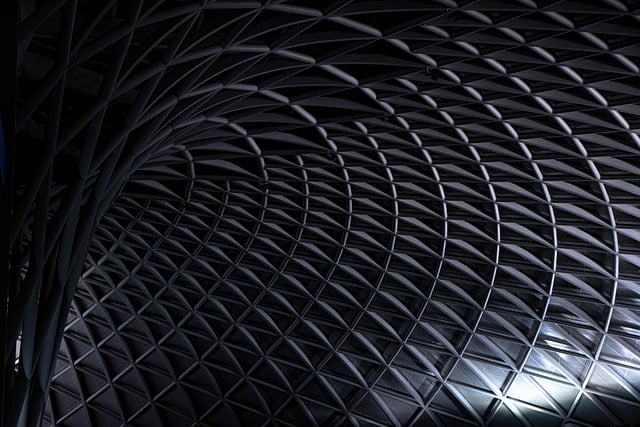Single-ply roofing systems (TPO, PVC, EPDM) are popular for commercial and residential applications due to their flexibility, puncture resistance, ease of installation, and effective waterproofing. These materials provide seamless barriers against water penetration, preventing leaks in flat roofs. Their lightweight nature, UV/temperature resistance, and chemical protection make them durable solutions, saving on future repairs. Installation involves meticulous substrate preparation, membrane securing, and following manufacturer guidelines for optimal leak prevention. Regular maintenance, including inspections and coatings, extends their lifespan, ensuring long-term protection against roof leaks in both residential and commercial settings.
“Elevate your understanding of flat roof waterproofing with single-ply systems like TPO, PVC, and EPDM. This comprehensive guide explores the benefits of these advanced materials for both commercial and residential applications, offering durable solutions for effective roof leak prevention. Discover how professional roof waterproofing experts leverage these technologies to ensure longevity and optimal performance. From installation best practices to maintenance tips, unlock the secrets to robust, waterproof roof coatings.”
Understanding Single-Ply Systems: TPO, PVC, and EPDM
Single-ply roofing systems, including TPO (Thermoplastic Olefin), PVC (Polyvinyl Chloride), and EPDM (Ethylene Propylene Diene Monomer), have gained significant popularity in both commercial and residential roof waterproofing applications. These systems offer a range of benefits for flat roofs, making them a preferred choice among professionals seeking reliable and durable solutions.
TPO, PVC, and EPDM are known for their superior flexibility, puncture resistance, and easy installation. They provide an effective barrier against water penetration, ensuring the longevity of rooftops. As waterproof roof coatings, these materials create a seamless membrane that prevents roof leaks, a common issue in flat roofing structures. Their lightweight nature also makes them easier to install and maintain compared to traditional roofing options, contributing to cost-effectiveness and reduced labor requirements.
Advantages of Using Single-Ply for Roof Waterproofing
Single-ply systems like TPO, PVC, and EPDM offer numerous advantages for roofing, particularly in terms of roof waterproofing. These materials are designed to create a seamless, continuous barrier over the roof surface, effectively preventing water infiltration and protecting against leaks. This makes them ideal both for commercial roof waterproofing and residential roof waterproofing, providing durable and long-lasting waterproof roof coatings.
Unlike multi-ply systems that can allow moisture to seep in through seams or joints, single-ply membranes are fully bonded to the substrate, eliminating these potential entry points. This results in a more efficient and effective roof leak prevention system, saving on costly repairs and replacements down the line. Additionally, these materials are lightweight, easy to install, and offer excellent resistance to UV rays, extreme temperatures, and chemical corrosion, making them versatile waterproofing solutions for various roofing applications, especially for waterproofing flat roofs.
Applications: Commercial and Residential Roofs
Single-ply roof systems like TPO (Thermoplastic Olefin), PVC (Polyvinyl Chloride), and EPDM (Ethylene Propylene Diene Monomer) are versatile and widely used for both commercial and residential roofs, offering effective roof waterproofing solutions. These systems are known for their ease of installation, durability, and exceptional roof leak prevention capabilities. They provide a seamless barrier, protecting against moisture intrusion and ensuring the longevity of structures.
For commercial roof waterproofing, TPO, PVC, and EPDM are popular choices due to their resistance to harsh environmental conditions and chemical exposure. They can handle high foot traffic and offer cost-effective protection for large-scale projects. In residential settings, these materials also excel in waterproof roof coatings, providing a reliable barrier against leaks while maintaining aesthetic appeal with various color options available.
Installation Process and Best Practices
The installation process for single-ply roofing systems like TPO, PVC, and EPDM involves several best practices to ensure optimal performance as roof waterproofing solutions. Professionals begin by preparing the substrate, cleaning and sealing any existing surfaces to create a smooth, dry base. The membranes are then carefully unrolled and secured with specialized fasteners or adhesives, ensuring proper overlap and sealing at joints for effective leak prevention systems.
Key installation tips include maintaining proper membrane tension to prevent bubbles or wrinkles, using compatible sealants for seamless connections, and following manufacturer guidelines for flashing around penetrations such as drains or vents. Regular inspection during and after installation is crucial for identifying potential issues early on. By adhering to these best practices, homeowners and commercial property managers can enjoy the benefits of durable, waterproof roof coatings that protect against damaging roof leaks in both residential and commercial settings.
Longevity and Maintenance: Preventing Roof Leaks with These Systems
Single-ply roofing systems like TPO (Thermoplastic Olefin), PVC (Polyvinyl Chloride), and EPDM (Ethylene Propylene Diene Monomer) are renowned for their exceptional longevity, making them a popular choice for both commercial and residential roof waterproofing solutions. These materials offer superior durability compared to traditional multi-ply systems, ensuring your roof remains leak-free for extended periods. Their seamless installation and flexible nature make them ideal for flat roofs, as they conform to the surface without leaving gaps or crevices where leaks can occur.
Regular maintenance plays a crucial role in extending the life of these systems. Professional roof waterproofing services recommend periodic inspections to identify any signs of wear, tearing, or damage. Applying waterproof roof coatings, such as those made from TPO or UV-resistant PVC, further enhances protection against leaks caused by sunlight and weather exposure. By combining the inherent durability of single-ply materials with proactive maintenance strategies, homeowners and commercial property managers can ensure their roofs remain in pristine condition for years to come, providing peace of mind and preventing costly repairs associated with roof leaks.
Single-ply roof waterproofing systems like TPO, PVC, and EPDM offer a reliable and efficient solution for both commercial and residential properties. Their superior water resistance, durability, and low maintenance requirements make them an excellent choice for waterproofing flat roofs. By choosing professional roof waterproofing services that specialize in these systems, property owners can ensure long-lasting protection against leaks and prolong the life of their rooftops. These modern solutions provide effective waterproof roof coatings, enhancing overall building integrity and offering peace of mind.
